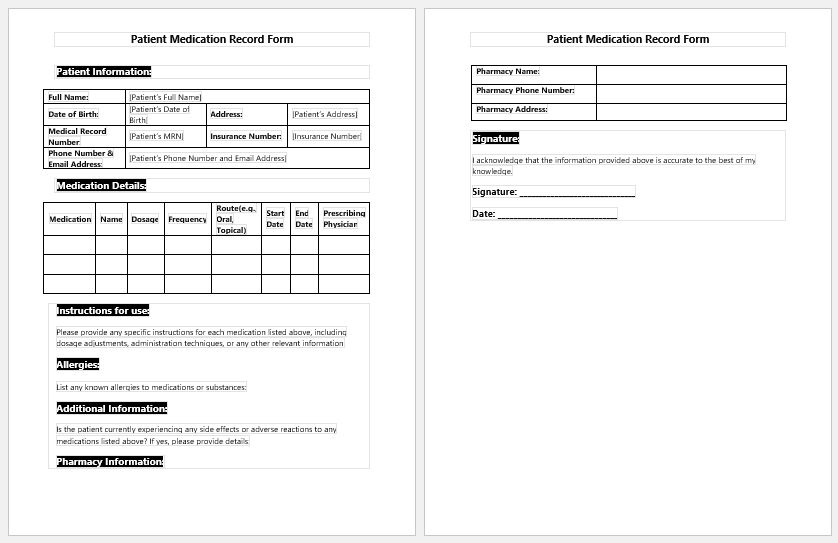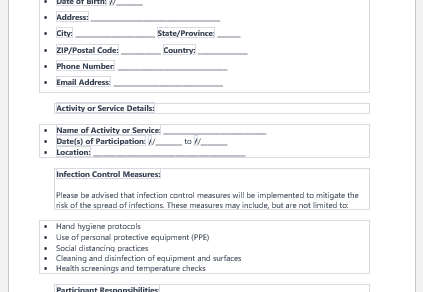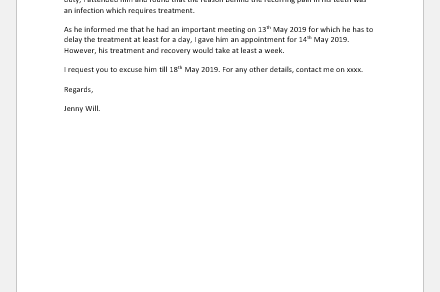Patient medication record forms are essential tools for healthcare professionals to record and manage patient medication information. These forms provide a thorough overview of a patient’s prescription history, including recommended medications, dosages, and administration schedules. These records are used by healthcare workers to monitor medication adherence, track adverse reactions, and ensure patient safety.
Some components of the form
Patient medication record forms typically include the following information:
- Patient information: This includes the patient’s name, date of birth, and contact information.
- Medication information: This section includes details about the medications administered to the patient, such as the name of the medication, dosage, administration instructions, and the prescribing physician’s name.
- Allergies and adverse reactions: This section details any allergies the patient may have to medications and any adverse reactions they have experienced.
- Medical history: The patient’s medical history, including current medical conditions, surgeries, hospitalizations, and chronic diseases, is included in this section.
- Other relevant information: This section may include any other relevant information about the patient’s health, such as their lifestyle habits or family medical history.
Use Cases
Patient medication record forms have several use cases in the healthcare industry. These forms are typically used for patient care as they provide comprehensive medication information to healthcare professionals providing care to the patient. These records help healthcare professionals ensure medication compliance and manage any adverse reactions.
Furthermore, on a patient’s admission to a hospital, their medication record form gives a comprehensive overview of their medication history. This information is critical to saving time on unnecessary tests and ensuring that the patient receives the correct medications during their stay in the hospital.
Patient medication record forms are also used to manage patient medications in long-term care settings, such as nursing homes or assisted living facilities. These records help healthcare professionals ensure that patients receive their medications as prescribed and monitor any adverse reactions.
Lastly, patient medication record forms are an essential tool for ensuring patient safety. Healthcare professionals can use these records to identify potential medication interactions and avoid prescribing medications that may cause harm to the patient.
Significance of the form
In healthcare environments, the use of patient medication document forms is crucial. These records assist healthcare workers in providing the best care possible to their patients by ensuring medication adherence, monitoring adverse reactions, and avoiding potential drug interactions. Similarly, these records provide a thorough overview of a patient’s medication history, which assists in spotting potential health issues and developing effective treatment plans.
With the digitalization of healthcare facilities, the industry is becoming paperless, and electronic health records (EHRs) have grown in popularity in recent years, replacing paper-based record-keeping in many healthcare contexts. Electronic medication records provide greater accuracy, accessibility, and security, which is essential in modern healthcare settings. The transition to electronic records, though, requires significant investments in technology and personnel training.
Conclusion
To conclude, patient medication record forms are an essential tool for healthcare professionals to manage patient medications. These records provide a comprehensive overview of a patient’s medication history, helping healthcare professionals ensure medication compliance, track adverse reactions, and avoid potential drug interactions.
While paper-based records are still prevalent in many healthcare settings, the transition to electronic health records is underway as they provide better accuracy, completeness, accessibility, and security so that the patient’s safety is ensured and the best possible care is provided.
- Nursing Documentation Templates
- Mental Health Evaluation Forms
- Forms Used by Pediatricians
- Various Forms Related to Pregnancy Verification
- Common Forms Used by ENT Specialists
- Pain Diary Worksheet Template
- Forms Commonly Used by Old Age Homes
- Medical Treatment Consent Form
- Home Exercise Program Worksheet
- Forms Used for Mental Health Assessment
- Forms Used by Psychologists
- Medical Forms Commonly Used by/for Students
- Assessment Consent Form
- Forms Used by an Anesthesiologist
- Not Fit to Fly Certificate Template


